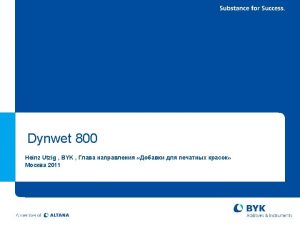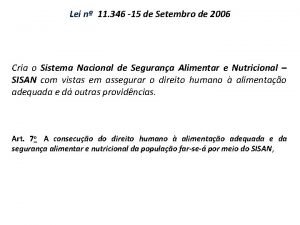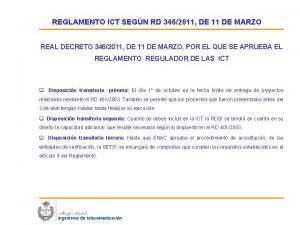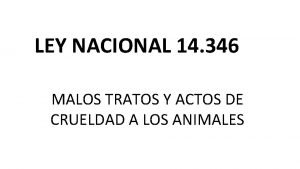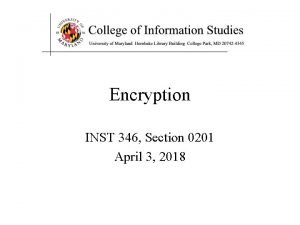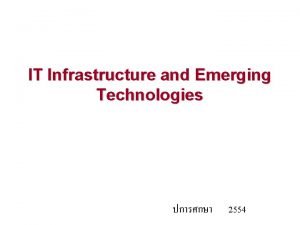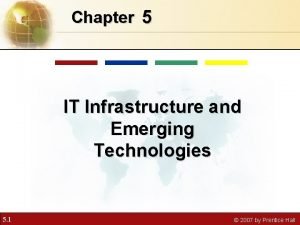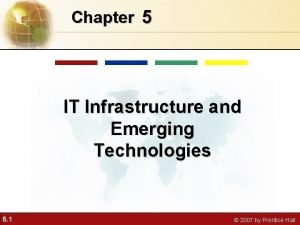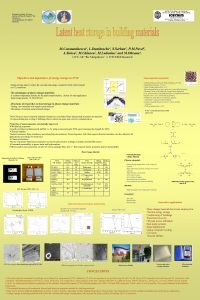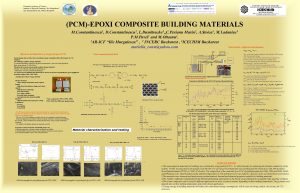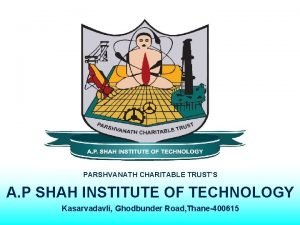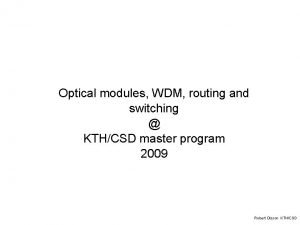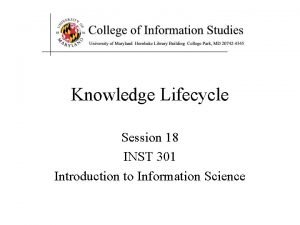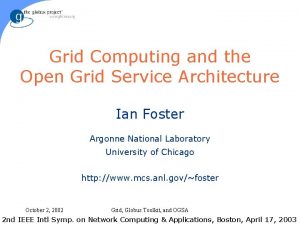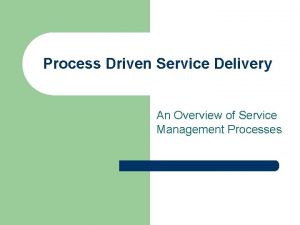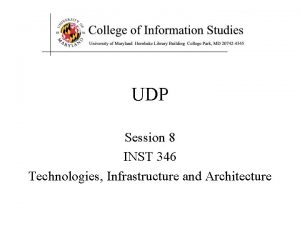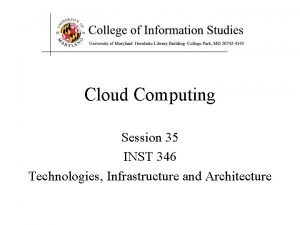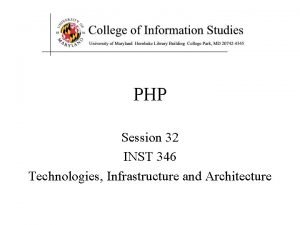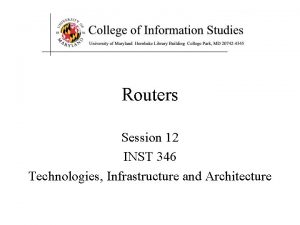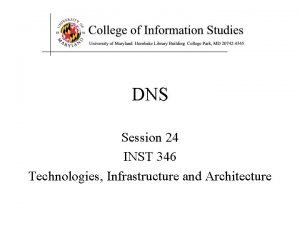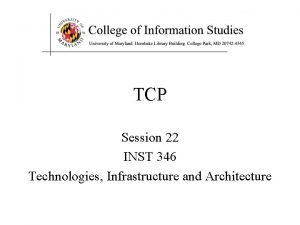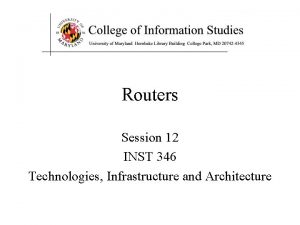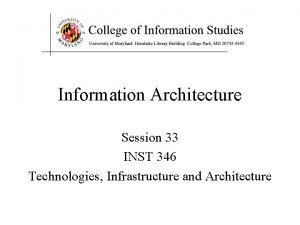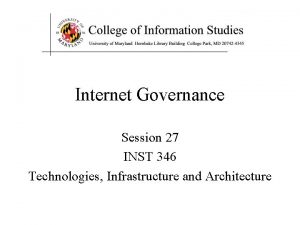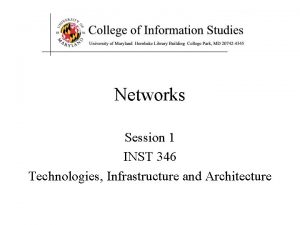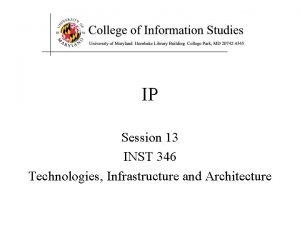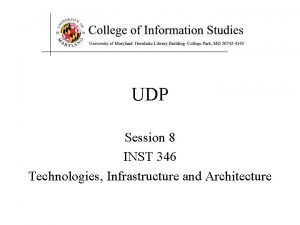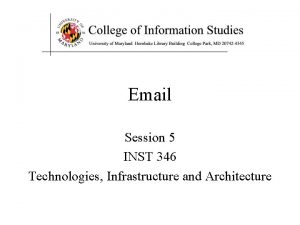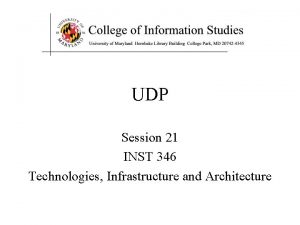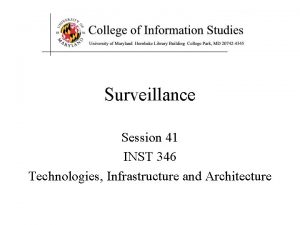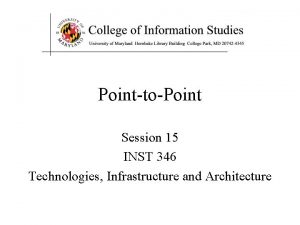Service Model Session 3 INST 346 Technologies Infrastructure






























- Slides: 30

Service Model Session 3 INST 346 Technologies, Infrastructure and Architecture

Goals for Today • Postgame the homework • Application-layer Internet API • Getahead: Hypertext Transfer Protocol • What to expect on Thursday’s quiz

Muddiest Points • Queueing delay formulas (La/R, …) • Circuit switching – Frequency Division Multiplexing • Transmission delay vs. propagation delay • ISP vs. IXP vs. Content Provider Network

Internet protocol stack § application: supporting network applications • FTP, SMTP, HTTP § transport: process-process data transfer • TCP, UDP § network: routing of datagrams from source to destination • IP, routing protocols § link: data transfer between neighboring network elements • Ethernet, 802. 111 (Wi. Fi), PPP § physical: bits “on the wire” application transport network link physical

ISO/OSI reference model § presentation: allow applications to interpret meaning of data, e. g. , encryption, compression, machine-specific conventions § session: synchronization, checkpointing, recovery of data exchange § Internet stack “missing” these layers! • these services, if needed, must be implemented in application presentation session transport network link physical

Why layering? dealing with complex systems: § explicit structure allows identification of, and describing relationship between complex system’s pieces § modularization eases maintenance, updating of system • change of implementation of layer’s service transparent to rest of system § some efficiency penalty • Worth it for general applications • Not practical in some specialized cases (e. g. , planetary missions)

Chapter 2: application layer our goals: § conceptual, aspects of network application protocols • transport-layer service models • client-server paradigm • (peer-to-peer paradigm) § learn to create network applications • socket API § learn about protocols by examining popular application-level protocols • Web: HTTP • Email: SMTP / POP 3 / IMAP • Domain Name Service

Some network apps § email § Web § streaming video (You. Tube, Hulu, Netflix, …) § remote login § FTP § P 2 P file sharing § voice over IP (e. g. , Skype) § multi-user network games § real-time conferencing § social networking § search

Creating a network app write programs that: application transport network data link physical § run on (different) end systems § communicate over network § e. g. , web server software communicates with browser software no need to write software for network-core devices § network-core devices do not run user applications § applications on end systems allows for rapid app development, application transport network data link physical

Client-server architecture (e. g. , Web) server: § always-on host § permanent IP address § data centers for scaling clients: client/server § communicate with server § may be intermittently connected § may have dynamic IP addresses § do not communicate directly with each other

P 2 P architecture (e. g. , Skype) § no central server § arbitrary end systems directly communicate § peers request service from other peers, provide service in return to other peers • self scalability – new peers bring new service capacity, as well as new service demands § peers are intermittently connected and change IP addresses • complex management peer-peer

Processes communicating process: program running within a host § within a host, processes communicate using inter -process communication (defined by OS) § processes in different hosts communicate by exchanging messages clients, servers client process: process that initiates communication server process: process that waits to be contacted § note: P 2 P applications have both client & server processes

Sockets § process sends/receives messages to/from its socket § socket is analogous to an outbox or inbox • sending process places a message in an “outbox” (socket) • sending process relies on transport infrastructure to deliver message to “inbox” (socket) at receiving process § sockets are identified by numbers • some sockets are defined by convention (e. g. , 80=Web server) application process socket application process transport network link physical Internet link physical controlled by app developer controlled by OS

The address of a socket § to send or receive messages, a process must have a socket § to identify that socket, the socket must have a unique identifier § Each host has a unique 32 -bit IP address • but many processes can be running on same host § the unique identifier for a socket includes both the IP address of the host and the port number(s) associated with that process § examples of “well known” port numbers: • Web server: 80 • mail server: 25 § to identify the gaia. cs. umass. edu web server: • IP address: 128. 119. 245. 12 • port number: 80 § processes can spawn new processes (and thus new port numbers)

App-layer protocol must define: § types of messages • e. g. , request, response § message syntax • what fields in messages • how fields are delineated § message semantics • meaning of information in fields § rules for when and how processes send & respond to messages “open” protocols: § e. g. , HTTP, SMTP § defined in “Requests for Comment” (RFC’s) § designed for interoperability proprietary protocols:

What transport service does an app need? data integrity throughput § some apps require 100% § some apps (e. g. , video) need some minimum reliable data transfer throughput § other apps (e. g. , audio) can § other apps (“elastic tolerate some loss apps”) make use of whatever throughput timing they get § some apps (e. g. , Internet telephony, security interactive games) require low delay § encryption, data integrity, …

Transport service requirements: common apps application file transfer e-mail Web documents audio/video interactive games text messaging data loss throughput timing no loss-tolerant loss-tolerant no loss elastic 5 kbps-1 Mbps 10 kbps-5 Mbps few kbps up elastic no limits 100’s msec few secs 100’s msec yes and no

Internet transport protocols UDP service (raw Internet): TCP service (pseudocircuit): § packet delivery service: no connection setup effort § unreliable data transfer between sending and receiving process § does not provide: reliability, flow control, congestion control, timing, throughput guarantee, security § connection-oriented: simulates a circuit between client and server processes (takes time to set up) § reliable transport between sending and receiving process § flow control: sender won’t overwhelm receiver § congestion control: throttle sender when network overloaded § does not provide: timing,

Internet apps: application, transport protocols application e-mail remote terminal access Web file transfer streaming media Internet telephony application layer protocol underlying transport protocol SMTP [RFC 2821] Telnet [RFC 854] HTTP [RFC 2616] FTP [RFC 959] HTTP, RTP [RFC 1889] SIP, RTP, proprietary TCP TCP UDP or TCP UDP (TCP fallback)

Securing TCP (Preview of Session 22) TCP (and UDP) § no encryption § passwds sent into socket traverse Internet in cleartext SSL § provides encrypted TCP connection § data integrity § end-point authentication SSL is at app layer § apps use SSL libraries, that “talk” to TCP

Getahead

The (World-Wide) Web § a web page consists of base HTML-file which includes several referenced objects § an object can be HTML file, JPEG image, Java applet, audio file, … § each object is addressable by a URL, e. g. , http: //www. someschool. edu/some. Dept/pic. gif protocol host name path name

HTTP overview HTTP: hypertext transfer protocol § Web’s application layer protocol § client/server model • client: “browser” requests (using HTTP), receives (using HTTP), and displays Web objects • server: “Web server” sends (using HTTP) objects in response to requests HT TP PC running Firefox browser req u est HT TP res pon e HT server running Apache Web server e s on p es Pr T i. Phone running Safari browser st e qu r TP HT se

HTTP uses TCP § client creates a socket and initiates a TCP connection to port 80 on server § server creates a new socket for this connection, forwards the TCP to that socket, and accepts the connection there. § HTTP messages (application-layer protocol messages) are exchanged between browser (HTTP client) and Web server (HTTP server) § Eventually, the TCP HTTP is “stateless” § server maintains no information about past client requests aside protocols that maintain “state” are complex! § past history (state) must be maintained § if server/client crashes, their views of “state” may be inconsistent, must be reconciled

HTTP (1. 0) suppose user enters URL: www. some. School. edu/some. Department/home. index 1. HTTP client initiates TCP connection to HTTP server (process) at www. some. School. edu on port 80 3. HTTP client sends HTTP request message (containing URL) into TCP connection socket. Message indicates that client wants object time some. Department/home. index 5. HTTP client receives response message containing html file, displays html. 7. Parsing html file, the browser finds 10 referenced jpeg objects and starts again at 1. (10 times!) 2. HTTP server at host www. some. School. edu waiting for TCP connection at port 80. “accepts” connection, notifying client of new port number 4. HTTP server receives request message, forms response message containing requested object, and sends message into its socket 6. HTTP server closes TCP connection.

HTTP (1. 0) response time Define Round Trip Time (RTT) as time for a small packet to travel from client to server and back HTTP response time: initiate TCP connection § one RTT to initiate TCP RTT connection § one RTT for HTTP request and request file first few bytes of HTTP RTT response to return § file transmission time file received § non-persistent HTTP response time = time 2*RTT+ file transmission time to transmit file time

HTTP evolution original HTTP (1. 0) § Set up TCP connection § Send one object § Close TCP connection § Can require many TCP connection setups for one Web page (slow!) persistent HTTP (1. 1 & later) § Set up the TCP connection once § Send all the objects on one Web page • Don’t close the connection after each request • Avoids repeated connection setups § Timeout: Close the TCP connection after some period with no activity

Better network utilization original HTTP (1. 0): persistent HTTP: § requires 2 RTTs per object § plus Operating System (OS) overhead for each TCP connection § workaround: browsers can open parallel TCP connections to fetch referenced objects § server leaves connection open after sending response § client sends requests as soon as it encounters a referenced object § as little as one RTT for all the referenced objects

Quizzes • Goals – Begin to prep for Exam 1 – Incentive to keep up with the readings • Format – Every Thursday (except exam weeks); see schedule – 5 minutes at start of class, sharply timed – On paper (write directly on the quiz) – Open book, open notes, open Web – No communication with anyone until quiz ends!

Before You Go On a sheet of paper, answer the following (ungraded) question (no names, please): What was the muddiest point in today’s class?
 Ist 346
Ist 346 Byk-346
Byk-346 Cranial nerve xi
Cranial nerve xi Rounding off hundred thousands
Rounding off hundred thousands Lei 11 346
Lei 11 346 Round 716 to the nearest hundred
Round 716 to the nearest hundred Rd 346 2011
Rd 346 2011 Stats-346
Stats-346 Ley 14 346
Ley 14 346 Cipher of 346
Cipher of 346 It infrastructure and emerging technologies
It infrastructure and emerging technologies It infrastructure and emerging technologies
It infrastructure and emerging technologies It infrastructure and emerging technologies
It infrastructure and emerging technologies It infrastructure and emerging technologies
It infrastructure and emerging technologies It infrastructure and emerging technologies
It infrastructure and emerging technologies Romanian banking institute
Romanian banking institute Rubiterm
Rubiterm Hresca inst
Hresca inst Parshvanath charitable trust ghodbunder road
Parshvanath charitable trust ghodbunder road Inst-154
Inst-154 Packing inst.
Packing inst. Lunar landing mission
Lunar landing mission Inst
Inst Gunger
Gunger Inst 301
Inst 301 Inst eecs
Inst eecs Service mesh conduit
Service mesh conduit Decibels
Decibels Open grid service infrastructure
Open grid service infrastructure Service delivery management definition
Service delivery management definition Service oriented infrastructure
Service oriented infrastructure

